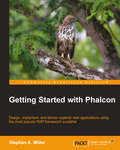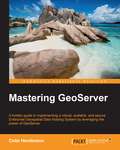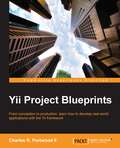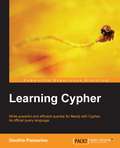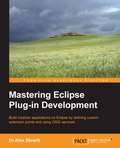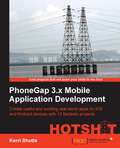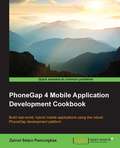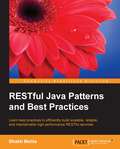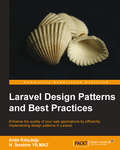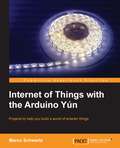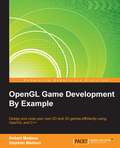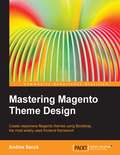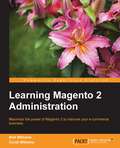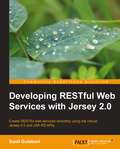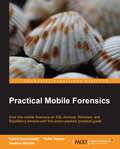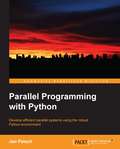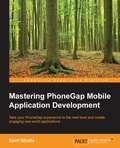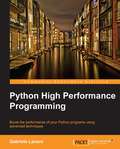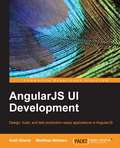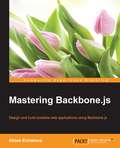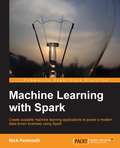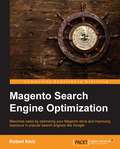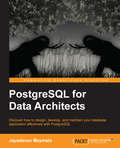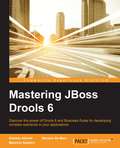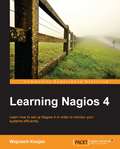- Table View
- List View
Getting Started with Phalcon
by Stephan A. MillerThis step-by-step, practical guide filled with detailed steps and screenshots will help you discover the Phalcon extension and will enable you to build your blog application with Phalcon quickly and easily. If you are a PHP developer with some knowledge and experience of working with PHP and you want to develop stunning web applications easily and quickly, then this book is perfect for you. Learning how to use Phalcon is perhaps the best way to explore the MVC architecture.
Mastering GeoServer
by Colin HendersonIf you are a GIS professional who intends to explore advanced techniques and get more out of GeoServer deployment rather than simply delivering good looking maps, then this book is for you.
Yii Project Blueprints
by Charles R. Portwood IIThis book is for intermediate-to-advanced level Yii developers who want to master the Yii framework and develop real-world applications. You should have experience of working with Yii, PHP 5, HTML, CSS, and JavaScript.
Learning Cypher
by Onofrio PanzarinoAn easy-to-follow guide full of tips and examples of real-world applications. In each chapter, a thorough example will show you the concepts in action, followed by a detailed explanation. This book is intended for those who want to learn how to create, query, and maintain a graph database, or who want to migrate to a graph database from SQL. It would be helpful to have some familiarity with Java and/or SQL, but no prior experience is required.
Mastering Eclipse Plug-in Development
by Dr Alex BlewittIf you are a Java developer who is familiar with the Eclipse plug-in environment, this book covers the advanced concepts that you need to know to achieve true expertise. Prior experience in creating Eclipse plug-ins is assumed for this book.
PhoneGap 2.x Mobile Application Development Hotshot
by Kerri ShottsThis book is a step-by-step guide about how to create a mobile app. Each chapter begins with the design of the user interface using wireframes as well as the data models using various diagrams. After the design, the chapter moves on to the implementation of the app, describing each block of code, including how it works and why it is needed in the context of the project. At the end of each project, various suggestions are proposed to help extend or enhance the project in order to stimulate your creativity and programming skills If you are a developer looking to create a mobile app using HTML, CSS, and JavaScript, this book is for you. While this book should be approachable for anyone looking to create mobile apps using PhoneGap, you should have some degree of experience using HTML, CSS, and JavaScript. You should also be able to create the basic PhoneGap project in the IDE of your choice (XCode, Eclipse, or Visual Studio). Understanding Java, C#, or Objective C is not required.
PhoneGap 4 Mobile Application Development Cookbook
by Zainul Setyo PamungkasIf you are a developer who wants to get started with mobile application development using PhoneGap, then this book is for you. Previous experience with data mining libraries will help, but is not mandatory. A basic understanding of web technologies such as HTML, CSS, and JavaScript is a must.
RESTful Java Patterns and Best Practices
by Bhakti MehtaThis book is aimed at novice developers who want to gain insights into building RESTful services and improve productivity, as well as for advanced developers who want to delve into more complicated topics.
Laravel Design Patterns and Best Practices
by Arda Kilicdagi H. Ibrahim YilmazThis book is a practical guide packed with clear examples that will help you get to grips with the best practices in Laravel design patterns to create advanced web applications. This book is intended for web application developers working with Laravel who want to increase the efficiency of their web applications. It assumes that you have some experience with the Laravel PHP framework and are familiar with coding OOP methods.
Internet of Things with the Arduino Yún
by Marco SchwartzAll projects are explained in a step-by-step manner, always starting with the assembly of the hardware and followed by basic tests of every hardware component. You will then learn how to build exciting applications in a practical manner based on the details of the projects. This book is intended for people who already have some experience with the Arduino platform and who want to build more exciting applications, in particular to Internet of Things. You will need to have some basic experience in electronics, Arduino, and programming in general to follow the projects created in the book.
OpenGL Game Development By Example
by Stephen Madsen Robert MadsenDesign and code your own 2D and 3D games efficiently using OpenGL and C++ About This Book * Create 2D and 3D games completely, through a series of end-to-end game projects * Learn to render high performance 2D and 3D graphics using OpenGL * Implement a rudimentary game engine using step-by-step code Who This Book Is For If you are a prospective game developer with some experience using C++, then this book is for you. Both prospective and experienced game programmers will find nuggets of wisdom and practical advice as they learn to code two full games using OpenGL, C++, and a host of related tools. What You Will Learn * Set up your development environment in Visual Studio using OpenGL * Use 2D and 3D coordinate systems * Implement an input system to handle the mouse and the keyboard * Create a state machine to handle complex changes in the game * Load, display, and manipulate both 2D and 3D graphics * Implement collision detection and basic physics * Discover the key components needed to complete a polished game * Handle audio files and implement sound effects and music In Detail OpenGL is one of the most popular rendering SDKs used to develop games. OpenGL has been used to create everything from 3D masterpieces running on desktop computers to 2D puzzles running on mobile devices. You will learn to apply both 2D and 3D technologies to bring your game idea to life. There is a lot more to making a game than just drawing pictures and that is where this book is unique! It provides a complete tutorial on designing and coding games from the setup of the development environment to final credits screen, through the creation of a 2D and 3D game. The book starts off by showing you how to set up a development environment using Visual Studio, and create a code framework for your game. It then walks you through creation of two games-a 2D platform game called Roboracer 2D and a 3D first-person space shooter game-using OpenGL to render both 2D and 3D graphics using a 2D coordinate system. You'll create sprite classes, render sprites and animation, and navigate and control the characters. You will also learn how to implement input, use audio, and code basic collision and physics systems. From setting up the development environment to creating the final credits screen, the book will take you through the complete journey of creating a game engine that you can extend to create your own games. Style and approach An easy-to-follow guide full of code examples to illustrate every concept and help you build a 2D and 3D game from scratch, while learning the key tools that surround a typical OpenGL project.
Mastering Magento Theme Design
by Andrea SaccaWritten in a step-by-step, tutorial style with a lot of code snippets and hands-on examples to create an advanced Magento theme from scratch, this book is tailor-made for web designers and developers. This book is great for developers and web designers who are looking to get a good grounding in how to create custom, responsive, and advanced Magento themes. Readers must have some experience with HTML, PHP, CSS, and Magento theme design. This book will be useful for anybody who already has knowledge of the Magento frontend structure.
Learning Magento 2 Administration
by Bret Williams Cyndi WilliamsMaximize the power of Magento 2 to improve your e-commerce business About This Book * Strategic planning for maximizing your Magento 2 store's operations and sales. * Important guidelines and advice for optimizing your Magento 2 store. * Packed with screenshots and step-by-step instructions to leverage the hundreds of Magento 2 features. Who This Book Is For This guide is for store owners who use Magento 2 on a daily basis to operate their online stores. Proprietors will use this guide as a reference for ensuring that they are utilizing the full power of Magento 2. Developers and solution providers will find this guide a helpful tool in identifying opportunities to help their clients navigate the complexity of Magento 2. What You Will Learn * Strategies for creating multiple stores within a single Magento installation. * Use of complex product types such as bundles, downloadables and virtual products. * Configuring payments, shipping and taxes. * Accommodating multiple languages and currencies. * Installing and configuring themes. * Managing content and search engine optimization. * Creating promotions, up-sells and cross-sells. * Leveraging the customer relationship features of Magento 2. * Securing and optimizing your installation. In Detail Magento 2 has been completely re-written and re-designed to take the world's most popular open source e-commerce platform to new heights of productivity and usability. With this overhaul comes improved opportunities to leverage the world's most successful open source e-commerce platform for your online retail and wholesale business. The focus of this book is on operational aspects: those actions you, as a proprietor, can take to give your customers a more delightful shopping experience. In this guide, we delve into all aspects of managing a Magento 2 store, from product creation to marketing, customer management to search engine optimization. This book is not only a step-by-step course in setting up your Magento 2 website, it will be a handy reference as continue to improve and refine your online presence. Style and approach A step-by-step guide where it takes the reader from the planning step all the way through launching a new Magento-powered store by building on the initial sample data included in a default Magento 2 installation. Along the way, we explore using discrete action steps how to leverage the full power of Magento 2 for both simple and advanced uses. Screenshots and step-by-step instructions not only teach the new Magento store administrator, but also serve as a handy reference for the more experienced operators.
Developing RESTful Web Services with Jersey 2.0
by Sunil GulabaniThe book will follow a standard tutorial approach and will teach readers how to use the Jersey API for creating RESTful web services.This book is intended for Java EE developers who are building applications on the REST architecture. This is a quick, hands-on guide for learning JAX-RS 2.0. Developers should have some knowledge about RESTful web services but it's not essential to know JAX-RS 1.0.
Practical Mobile Forensics
by Rohit Tamma Heather Mahalik Satish BommisettyThe book is an easy-to-follow guide with clear instructions on various mobile forensic techniques. The chapters and the topics within are structured for a smooth learning curve, which will swiftly empower you to master mobile forensics. If you are a budding forensic analyst, consultant, engineer, or a forensic professional wanting to expand your skillset, this is the book for you. The book will also be beneficial to those with an interest in mobile forensics or wanting to find data lost on mobile devices. It will be helpful to be familiar with forensics in general but no prior experience is required to follow this book.
Parallel Programming with Python
by Jan PalachA fast, easy-to-follow and clear tutorial to help you develop Parallel computing systems using Python. Along with explaining the fundamentals, the book will also introduce you to slightly advanced concepts and will help you in implementing these techniques in the real world. If you are an experienced Python programmer and are willing to utilize the available computing resources by parallelizing applications in a simple way, then this book is for you. You are required to have a basic knowledge of Python development to get the most of this book.
Mastering PhoneGap Mobile Application Development
by Kerri ShottsTake your PhoneGap experience to the next level and create engaging real-world applications About This Book * Create a useful PhoneGap workflow for larger projects in order to simplify and manage the development process * Use third-party plugins, IndexedDB, and SQLite for PhoneGap to develop large-scale, data-driven, and highly accessible applications * A pragmatic guide to construct top-notch large-scale applications using PhoneGap Who This Book Is For If you have created simple applications using PhoneGap in the past and now want to take your workflow and apps to the next level, this book will help you reach your goals. You should have a good working knowledge of HTML, CSS, and JavaScript, and prior experience with PhoneGap. What You Will Learn * Construct build workflows that simplify complex application development * Integrate the next version of JavaScript to simplify your code * Create accessible hybrid applications * Persist and query data using third-party database plugins * Create your own PhoneGap plugins for your unique use cases * Create icons and splash screens suitable for submission to app stores * Publish your app to the Google Play and Apple iTunes stores In Detail PhoneGap is a useful and flexible tool that enables you to create complex hybrid applications for mobile platforms. In addition to the core technology, there is a large and vibrant community that creates third-party plugins that can take your app to the next level. This book will guide you through the process of creating a complex data-driven hybrid mobile application using PhoneGap, web technologies, and third-party plugins. A good foundation is critical, so you will learn how to create a useful workflow to make development easier. From there, the next version of JavaScript (ES6) and the CSS pre-processor SASS are introduced as a way to simplify creating the look of the mobile application. Responsive design techniques are also covered, including the flexbox layout module. As many apps are data-driven, you'll build an application throughout the course of the book that relies upon IndexedDB and SQLite. You'll also download additional content and address how to handle in-app purchases. Furthermore, you'll build your own customized plugins for your particular use case. When the app is complete, the book will guide you through the steps necessary to submit your app to the Google Play and Apple iTunes stores. Style and approach This book is a step-by-step guide, in which the concepts covered are explained with the help of hands-on examples
Python High Performance Programming
by Gabriele LanaroAn exciting, easy-to-follow guide illustrating the techniques to boost the performance of Python code, and their applications with plenty of hands-on examples.If you are a programmer who likes the power and simplicity of Python and would like to use this language for performance-critical applications, this book is ideal for you. All that is required is a basic knowledge of the Python programming language. The book will cover basic and advanced topics so will be great for you whether you are a new or a seasoned Python developer.
AngularJS UI Development
by Amit Gharat Matthias NehlsenThis book is ideal for developers who have some experience in Java application development as well as some basic knowledge of test doubles and JUnit testing. This book also introduces you to the fundamentals of JUnit testing, test doubles, refactoring legacy code, and writing JUnit tests for GWT and web services.
Mastering Backbone.js
by Abiee EchameaDesign and build scalable web applications using Backbone.jsAbout This BookLevel up your Backbone.js skills and create professional web applications with the best practicesUse the Backbone.js components in the right way and avoid maintenance nightmaresImprove your development workflow from application design to deploymentApply the best practices given in this tutorial to solve day-to-day problems in your applicationsWho This Book Is ForThis book is for those developers who know the basic concepts of Backbone.js and want to build scalable applications with it. If you are looking for the best practices of using Backbone.js applied to real work applications, this book is for you. You will be able to apply architectural principles to create amazing web applications easily.What You Will LearnBuild web applications that scale with Backbone.jsDesign a powerful architecture that eliminates maintenance nightmaresUse common patterns and best practices in Backbone.js web applications developmentsPack your applications to be deployed to production environmentsClean up your code organization to a simple and maintainable architectureTest your components and get confidence with your codeDeal with common scenarios like file uploading and login issuesIn DetailBackbone.js is a popular library to build single page applications used by many start-ups around the world because of its flexibility, robustness and simplicity. It allows you to bring your own tools and libraries to make amazing webapps with your own rules. However, due to its flexibility it is not always easy to create scalable applications with it. By learning the best practices and project organization you will be able to create maintainable and scalable web applications with Backbone.js.With this book you will start right from organizing your Backbone.js application to learn where to put each module and how to wire them. From organizing your code in a logical and physical way, you will go on to delimit view responsibilities and work with complex layouts.Synchronizing models in a two-way binding can be difficult and with sub resources attached it can be even worse. The next chapter will explain strategies for how to deal with these models. The following chapters will help you to manage module dependencies on your projects, explore strategies to upload files to a RESTful API and store information directly in the browser for using it with Backbone.js. After testing your application, you are ready to deploy it to your production environment. The final chapter will cover different flavors of authorization.The Backbone.js library can be difficult to master, but in this book you will get the necessary skill set to create applications with it, and you will be able to use any other library you want in your stack.Style and approachThis book takes a tutorial approach to help you scale your Backbone.js applications. It builds a web application using the best practices and applies architectural design principles to develop maintainable web-apps. Each chapter explains the design decisions and improves the project that is used as an example alongside the book.
Machine Learning with Spark
by Nick PentreathIf you are a Scala, Java, or Python developer with an interest in machine learning and data analysis and are eager to learn how to apply common machine learning techniques at scale using the Spark framework, this is the book for you. While it may be useful to have a basic understanding of Spark, no previous experience is required.
Magento Search Engine Optimization
by Robert KentThis book is an easy-to-follow tutorial with best practices and advanced references which will help you to take full advantage of Magento with SEO. This book is aimed at both Magento developers and SEO specialists who wish to optimize search and end user elements such as click-through rates to ensure the design of their online shop sites effectively maximize sales. Magento store owners may also find large sections of this book useful in order to understand the larger impact small tweaks and changes can have on SEO - especially when editing products and categories. This book assumes that the reader will understand the basic concepts of keyword research and the external factors that are required in order to manage an on-going SEO campaign.
PostgreSQL for Data Architects
by Jayadevan MaymalaThis book is for developers and data architects who have some exposure to databases. It is assumed that you understand the basic concepts of tables and common database objects, including privileges and security.
Mastering JBoss Drools 6
by Mauricio Salatino Esteban Aliverti Mariano De MaioDiscover the power of Drools 6 and Business Rules for developing complex scenarios in your applications About This Book * Implement and model different rules using the DRL full syntax * Model complex business decisions and domain models in order to automate and improve your operational decisions with the Drools framework * A practical, fast-paced, hands-on guide to help you use the different components provided by the Drools Rule Engine Who This Book Is For This book is for Java developers and architects who need to have a deep understanding of how to create or integrate your applications with the Drools Rules Framework. The book assumes that you know the Java language well and also have experience with some widely used frameworks, such as Spring. You should also know the basics of Maven-based applications. What You Will Learn * Automate your application's decisions, such as promotion applying, discount policies, fraud detection, and more. * Quickly get started with writing your first rules using the DRL full syntax. * Discover the power of the new syntax components of the rule language. * Define inferences in your business rules to simplify complex decisions. * Write decision tables, templates,domain-specific languages, and scorecards, and learn how to map them to the Drools framework. * Harness the full operational power of Drools through all of its configuration points. * Use Drools configurations and architectures for different environments and scenarios. In Detail Mastering JBoss Drools 6 will provide you with the knowledge to develop applications involving complex scenarios. You will learn how to use KIE modules to create and execute Business Rules, and how the PHREAK algorithm internally works to drive the Rule Engine decisions. This book will also cover the relationship between Drools and jBPM, which allows you to enrich your applications by using Business Processes. You will be briefly introduced to the concept of complex event processing (Drools CEP) where you will learn how to aggregate and correlate your data based on temporal conditions. You will also learn how to define rules using domain-specific languages, such as spreadsheets, database entries, PMML, and more. Towards the end, this book will take you through the integration of Drools with the Spring and Camel frameworks for more complex applications. Style and approach Approached from a developer's perspective, the book teaches you all the advanced concepts of Business Rules applicable examples with helpful screenshots, diagrams, tutorials, and examples.
Learning Nagios 4
by Wojciech KocjanThis book will introduce Nagios to readers who are interested in monitoring their systems. All the concepts in the book are explained in a simplified manner, presented in an easy-to-understand language with lots of tips, tricks, and illustrations. This book is great for system administrators interested in using Nagios to monitor their systems. It will also help professionals who have already worked with earlier versions of Nagios to understand the new features of Nagios 4 and provides usable solutions to real-life problems related to Nagios administration. To effectively use this book, system administration knowledge is required. If you want to create your own plug-ins, knowledge of scripting languages like Perl, shell and Python is expected.
